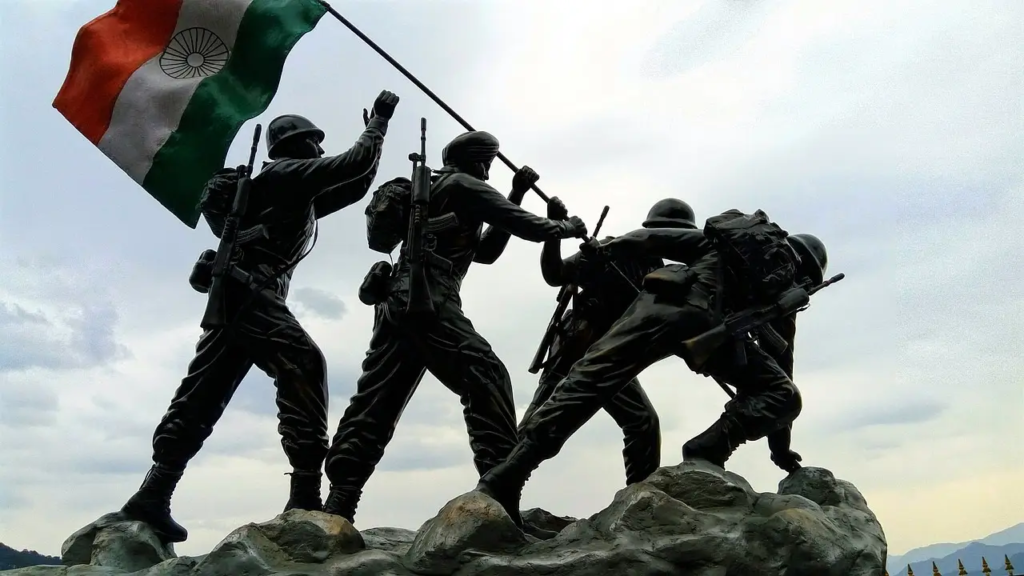
Table of Contents
- Introduction: A Day Etched in Courage
- The Silent Infiltration: Prelude to War
- Operation Vijay: India’s Bold Counteroffensive
- Heroes in Uniform: Tales from the Frontlines
- The Strategic Terrain: Why Kargil Mattered
- Global Response and Media Impact
- The Cost of Victory: Sacrifice and Loss
- Kargil’s Legacy: Lessons in Valor and Vigilance
- How the Nation Remembers: Commemorations and Memorials
- Conclusion: Beyond Borders and Bullets
1. Introduction: A Day Etched in Courage
Every year on 26th July, India bows in gratitude to the bravehearts of the Indian Armed Forces. Kargil Vijay Diwas is not just a day of remembrance—it’s a celebration of resilience, strategy, and supreme sacrifice. It marks the victory of India in the Kargil War of 1999, fought in one of the most inhospitable terrains in the world.
2. The Silent Infiltration: Prelude to War
In early 1999, as the snow melted in the Kargil sector of Jammu & Kashmir, Indian patrols made a chilling discovery—Pakistani troops and militants had stealthily occupied strategic heights. What began as suspicion quickly escalated into a full-blown war, as India realized the extent of the intrusion.
3. Operation Vijay: India’s Bold Counteroffensive
The Indian Armed Forces launched Operation Vijay, a meticulously planned and executed military campaign to reclaim the occupied peaks. Fighting at altitudes above 16,000 feet, the Indian Army and Air Force displayed extraordinary grit, pushing back the enemy in an environment where even survival was a challenge.
4. Heroes in Uniform: Tales from the Frontlines
Names like Captain Vikram Batra, Lieutenant Manoj Kumar Pandey, and Grenadier Yogendra Singh Yadav became symbols of fearless determination. Their actions were not just military maneuvers; they were stories of personal courage, of men who charged uphill into enemy fire so that the nation could sleep in peace.
5. The Strategic Terrain: Why Kargil Mattered
The peaks of Kargil weren’t just snow-covered mountains—they were vantage points overlooking critical highways, like NH1 that connects Srinagar to Leh. Control over these points meant control over supply lines. The battle wasn’t just for land, but for India’s strategic integrity.
6. Global Response and Media Impact
The world watched as India chose a restrained yet firm military approach. International diplomatic pressure mounted on Pakistan, and global sympathy leaned towards India’s justified defense. Meanwhile, Indian media played a pivotal role, bringing real-time war updates to citizens and building a wave of national solidarity.
7. The Cost of Victory: Sacrifice and Loss
The triumph came at a heavy price. Over 500 Indian soldiers laid down their lives, and many more were wounded. Behind every victory cry was a family that bore a personal loss. Their stories are etched into the soil of Kargil, whispered by the winds that blow across Tololing, Tiger Hill, and Dras.
8. Kargil’s Legacy: Lessons in Valor and Vigilance
Kargil was more than a military engagement; it was a wake-up call. It reinforced the importance of intelligence, surveillance, and terrain readiness. The war redefined India’s military doctrines and reshaped its defense priorities in the decades that followed.
9. How the Nation Remembers: Commemorations and Memorials
Today, the Kargil War Memorial in Dras stands tall, etched with the names of the fallen. Every Vijay Diwas, families of martyrs, veterans, and citizens gather to light candles, share stories, and renew their vow to never forget. Schools, institutions, and social platforms reverberate with patriotic tributes.
10. Conclusion: Beyond Borders and Bullets
Kargil Vijay Diwas is not just about military success; it’s about the spirit of a nation that refuses to bow. It’s a reminder that courage can scale any height, that love for one’s land can move mountains, and that victory, when earned with honor, becomes timeless.

